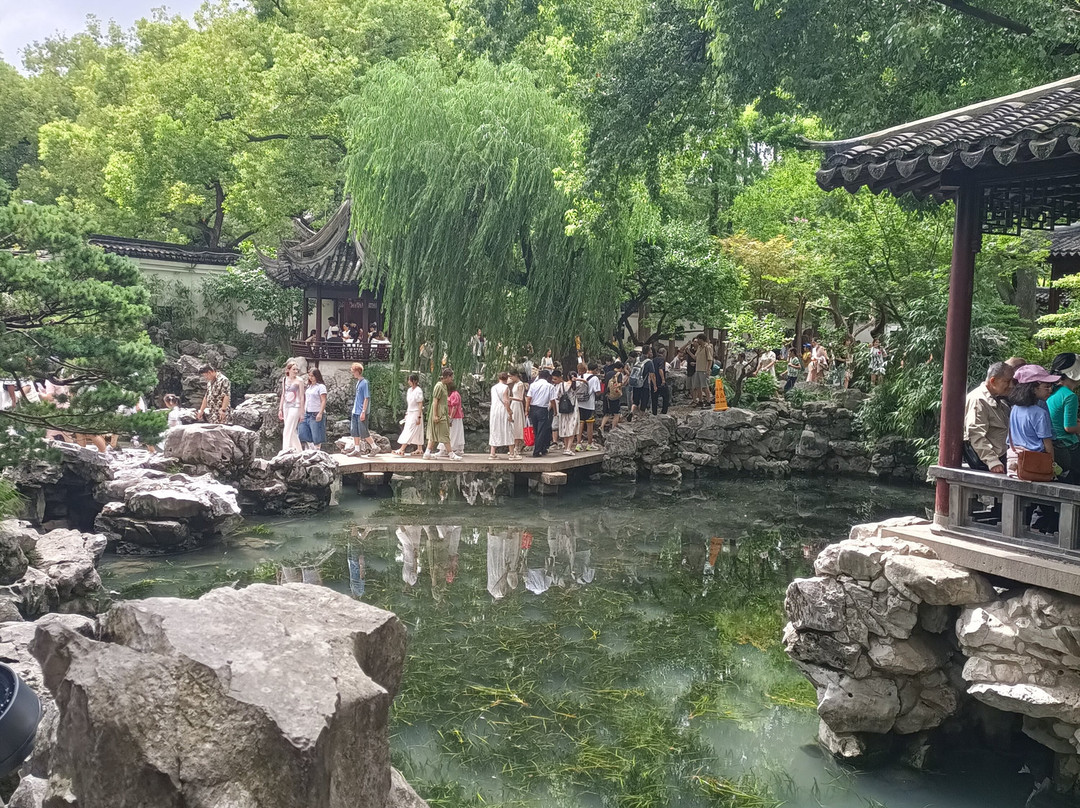的点评
A sight not to be missed.
豫园的点评
点评:In a city like Shanghai, fascinating but lacking in truly ancient monuments, Yu Garden is a destination not to be missed, despite the overwhelming crowds (at least that was our experience in July).
The garden, along with the ponds and pavilions that complemented it, can be traced back to specific dates: construction lasted from 1559 to 1577, primarily because the owner, the official Pan Yunduan, had to serve as governor of the distant province of Sichuan for a time.
This garden hasn't been immune to damage, and from the mid-19th century (the First Opium War) until the 1940s, it even risked total destruction. It's therefore important to be aware that the garden's current appearance is the result of sometimes radical restorations.
The result of these restorations is the current phantasmagoria of lush trees and shrubs; ponds teeming with carps; rocks aiming to evoke real, albeit miniature, landscapes; walkways spanning the ponds and connecting the various pavilions.
Speaking of real landscapes: a rock composition in the garden is indicated, that is intended to evoke, on a scale, the Himalayas.
As for the pavilions, the one called Yuhua Tang stands out, decorated with exquisitely carved wooden doors.
After visiting the garden, I read that each part of the garden itself is intended to represent a "subtopic" of the overall theme, which is that of the pleasant and satisfying way of living life. Too bad I wasn't aware of these meanings when I visited!
The garden, along with the ponds and pavilions that complemented it, can be traced back to specific dates: construction lasted from 1559 to 1577, primarily because the owner, the official Pan Yunduan, had to serve as governor of the distant province of Sichuan for a time.
This garden hasn't been immune to damage, and from the mid-19th century (the First Opium War) until the 1940s, it even risked total destruction. It's therefore important to be aware that the garden's current appearance is the result of sometimes radical restorations.
The result of these restorations is the current phantasmagoria of lush trees and shrubs; ponds teeming with carps; rocks aiming to evoke real, albeit miniature, landscapes; walkways spanning the ponds and connecting the various pavilions.
Speaking of real landscapes: a rock composition in the garden is indicated, that is intended to evoke, on a scale, the Himalayas.
As for the pavilions, the one called Yuhua Tang stands out, decorated with exquisitely carved wooden doors.
After visiting the garden, I read that each part of the garden itself is intended to represent a "subtopic" of the overall theme, which is that of the pleasant and satisfying way of living life. Too bad I wasn't aware of these meanings when I visited!
翻译:在上海这样一座魅力无穷却缺乏真正古老遗迹的城市,豫园是一个不容错过的目的地,尽管人潮拥挤(至少我们七月份的经历是这样的)。
豫园以及与之相得益彰的池塘和亭台楼阁的历史可以追溯到特定的时期:修建于1559年至1577年,主要是因为园主潘允端曾一度担任遥远的四川省巡抚。
豫园也未能幸免于难,从19世纪中叶(第一次鸦片战争)到20世纪40年代,它甚至一度面临彻底毁坏的危险。因此,值得注意的是,豫园如今的面貌是经过多次彻底修复的结果。
这些修复的成果是如今郁郁葱葱的树木和灌木丛、鲤鱼成群的池塘、旨在营造真实(尽管是微型)景观的岩石;步道横跨池塘,连接着各个亭台楼阁。
说到真实的景观:花园里有一处岩石构图,其设计旨在唤起人们对喜马拉雅山脉的联想。
说到亭台楼阁,其中尤以名为“雨花堂”的亭台楼阁最为引人注目,其木门雕花精美。
参观完花园后,我了解到花园的每个部分都旨在代表整体主题的一个“子主题”,即愉悦而满足的生活方式。可惜我参观时并没有意识到这些含义!
豫园以及与之相得益彰的池塘和亭台楼阁的历史可以追溯到特定的时期:修建于1559年至1577年,主要是因为园主潘允端曾一度担任遥远的四川省巡抚。
豫园也未能幸免于难,从19世纪中叶(第一次鸦片战争)到20世纪40年代,它甚至一度面临彻底毁坏的危险。因此,值得注意的是,豫园如今的面貌是经过多次彻底修复的结果。
这些修复的成果是如今郁郁葱葱的树木和灌木丛、鲤鱼成群的池塘、旨在营造真实(尽管是微型)景观的岩石;步道横跨池塘,连接着各个亭台楼阁。
说到真实的景观:花园里有一处岩石构图,其设计旨在唤起人们对喜马拉雅山脉的联想。
说到亭台楼阁,其中尤以名为“雨花堂”的亭台楼阁最为引人注目,其木门雕花精美。
参观完花园后,我了解到花园的每个部分都旨在代表整体主题的一个“子主题”,即愉悦而满足的生活方式。可惜我参观时并没有意识到这些含义!

此点评仅代表旅行者个人的主观意见,并不代表TripAdvisor以及其合作方的意见。
关于我们
|
新闻动态
|
商务合作
|
会员中心
|
业主中心
|
业主通
|
常见问题
|
意见反馈
|
联系我们
|
营业执照
© 2025 Tripadvisor 版权所有。
使用条款 |隐私政策 |网站工作原理
部分照片由 VFM Leonardo 提供。
* Tripadvisor不是旅行社,也不是旅游预订服务代理商。我们提供免费、客观、公正的旅游资讯服务。 (显示更多)
TripAdvisor LLC 既不是预订代理商,也不是旅游运营商,不会向网站用户收取任何服务费。 按照规定,在 Tripadvisor 发布机票价格、游览和旅行套餐的合作伙伴(航空公司、旅行提供商及预订代理商),其标价须包含所有费用和附加费用。 例如, 机场出入境税费、消费税与其他服务费、手续费、杂费及附加费用。 当您向我们的某个合作伙伴进行预订时,请务必查阅他们的网站以了解当地行政部门要求的所有适用费用的具体情况。 除非另有说明,机票价格通常指的是一个人的价格(以人民币计)。
为方便起见,TripAdvisor LLC 根据从我们的预订合作伙伴获取的空房率计算每个酒店的均价。 对于游览和景点来说,所显示价格通常是每位成人的最低可用价格。 对于列出的任何旅行套餐或优惠,TripAdvisor LLC 无法保证任何特定的费率或价格。 此外,酒店均价每晚会更新,并以您的首选币种表示(使用现行汇率)。 由于这些已换算的价格是预估价格,因此,有关具体金额和币种请与预订网站进行核实。
此外,TripAdvisor LLC 无法保证我们网站上宣传的价格随时有效。 标价可能需要预订一定天数才能生效,或有不可用日期、使用条件或限制。
TripAdvisor公司对外部网站的内容一概不负责。优惠价格中不含税和其他费用。
ICP证:沪B2-20200433
沪ICP备20013175号
 沪公网安备31010502005427号
沪公网安备31010502005427号鹰程信息技术(上海)有限公司
货币/国家及地区
¥CNY
中国

